It was a long, arduous undertaking, but I did it, and most everything was well received. I waffled between making little dishes of banchan myself or buying it, but in the end the things I wanted were simple enough, and only ended up buying the kimchi (I'm not sure I'll ever come to a point where I'll feel I need to make THAT myself).
One learning that came from this experience is that it's well worth taking the time to make the main courses, but maybe not so much the banchan unless I'm feeding a lot of people over the course of several days. The banchan dishes I chose, while very simple to prepare, are nevertheless time consuming, especially when preparing a bunch of other dishes, as I did.
Here, then, are the various dishes I made, along with a few cooking notes and how each was received.
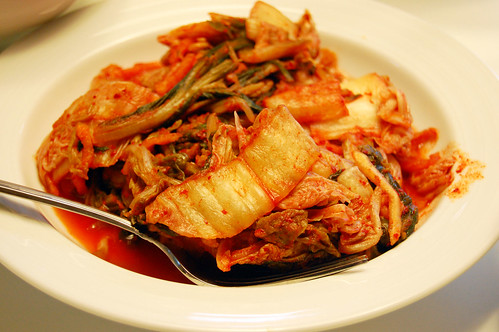
Kimchi, the only dish not made from scratch. It was okay. I have yet to find a brand of store-bought kimchi that I really like. The kind served at Korean restaurants tend to be much better than what I can find at the grocery store (even H-Mart, a Korean grocery store).
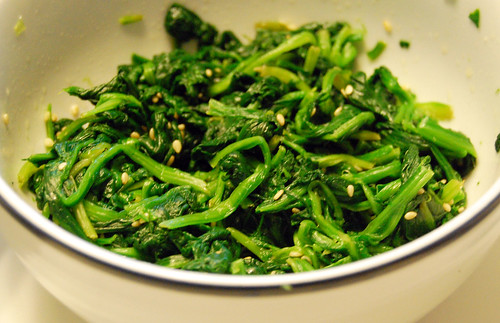
Sigeumchi Namul, or seasoned spinach, made by dropping the spinach into hot water for 1 minute, then seasoning with sesame seeds, sesame oil, and salt. Very good and simple, but quite a bit of work due to all the washing that's required.
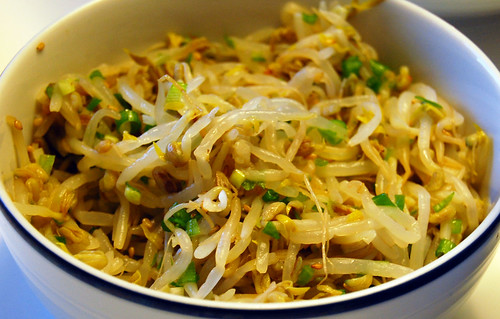
Kong Namul, or seasoned bean sprouts, made by steaming the sprouts (in this case, mung bean sprouts, though traditionally it is made with soy bean sprouts) for a few minutes, then seasoning with scallions, sesame seeds, sesame oil, and salt. Very good and simple, but a bit time consuming.
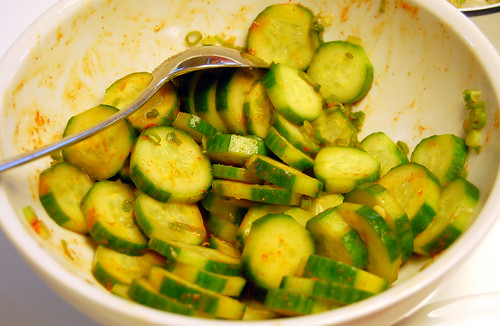
Oi Muchim, or spicy cucumber salad. Small Persian or Kirby cucumbers are sliced, then mixed with scallions, sesame oil, cider vinegar, and gochujang. This was only okay, even though it's usually one of my favorite banchan. The problem was that the gochujang I used was WAY too spicy, so that I wasn't able to put much of it in. That made the cucumbers under-seasoned.

Sangchu Kutjuri, or mixed simple salad, which I've found to be ubiquitous during Korean barbecue meals. However, I'm not sure how traditional it actually is, as it was actually difficult to find a Korean cookbook that had a recipe for it. It's red-leaf lettuce, hand shredded, with thinly sliced scallions and a simple dressing that's sweet, savory, and sour all at once. It's wonderful. My version was pretty good, but not nearly as good as I've had at restaurants. More experimentation is a must!
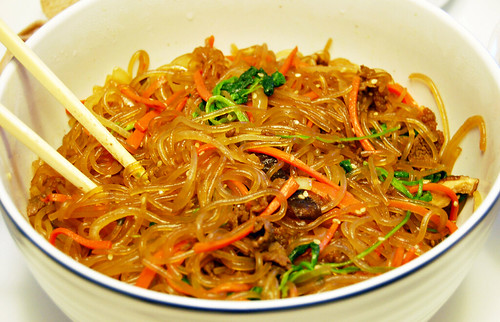
Jap Chae, or glass noodles with beef and vegetables. This went down like gangbusters. Everyone loved it. It was delicious, and very authentic tasting. The glass noodles are made from sweet potato starch, and turn translucent when stir fried. The noodles are mixed with seasoned beef, matchstick carrots, onion, shitake mushrooms, and spinach (which I added a bit late, so it's kind of clumpy in the dish). Really wonderful, well worth the time it took to make.
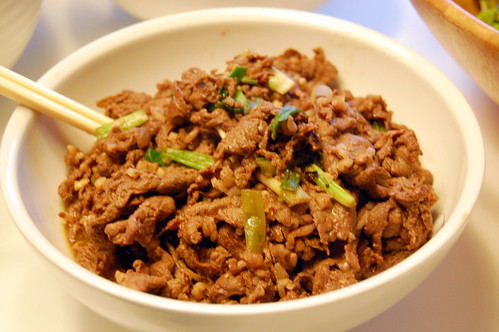
Bulgogi, or the well-known sweet and savory "barbecued" beef that's thinly sliced. This was an incredibly simple and delicious dish -- all that's needed is for the beef to mature in the marinade. Also a hit with everyone.
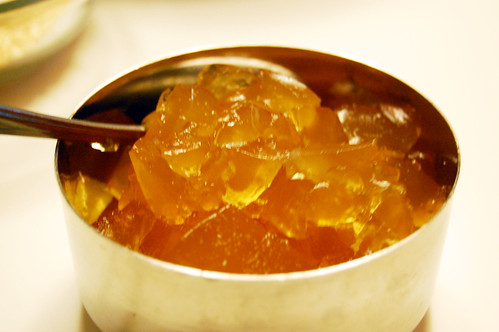
Saenggang Jelly, or ginger jelly. Most decidedly NOT a hit with everyone. First you have to really, REALLY enjoy the taste of ginger. Then you have to enjoy the heat in your mouth after a few mouthfuls of this super strong dessert. It creeps up on you, and just isn't very pleasant. Even those among us who enjoy ginger a lot couldn't handle eating all of it. Granted, we didn't drizzle it with dark corn syrup as the recipe indicated (because we didn't have any), so I don't know if that would have made a big difference. Honestly though, I can't remember EVER having a Korean dessert in a restaurant setting, and recipes for them in cookbooks seem very sparse; maybe dessert just isn't a forte of the cuisine.
I also made something else that I neglected to take a picture of, that everyone absolutely loved: Kom Tang, or beef bone soup. I actually don't even know how Korean it was, since I made a lot of adjustments, especially toward the end when I was running out of time. The recipe calls for beef knuckles, but I couldn't find it at either H-Mart nor 99 Ranch, so I ended up using beef neck bones instead. That right there might make it un-Korean, I don't know. I was also supposed to cut the meat and cartilage from the bones and drop the former but not the latter back into the soup; I skipped this step entirely. We're used to eating meat from bones in soup, after all. I also did not remove the carrot and onion, again due to time contraint. I used daikon, which I had on hand, which I'm not sure if that can be considered "Korean radish" (the recipe does not get more specific than that). Finally, I neglected to add all of the ingredients that I was supposed to at the end, because I just plain forgot, lol. Yet, as I said, everyone LOVED the soup!
I wanted to make "purple rice," which seems to be pretty standard at Korean restaurants, but it turns out that you have to soak black rice (a bit of black rice mixed with white rice is what turns the rice violet in color) for hours and hours before it softens enough to be cooked with white rice, which I didn't realize. So we just had regular sticky white rice.
All in all, a big success, and a few of these dishes will likely find themselves in my permanent repertoire!
Jap Chae (recipe adapted from The Korean Table)
Ingredients:
- 1 tbsp Sweet Soy Base Sauce (recipe follows)
- 1 tbsp minced green onion
- 1 tsp dark sesame oil
- 1/4 lb sirloin tips or ribeye steak, cut into matchstick strips
- 5 oz dried Korean vermicelli noodles
- 1/2 lb spinach
- 2 tbsp canola or other neutral oil
- 1 small onion, sliced
- 1 carrot, peeled and cut into matchstick strips
- 8 dried shitake mushrooms, reconstituted in water and cut into matchstick strips
- 1 tbsp dark sesame oil
- 5 tbsp Sweet Soy Base Sauce
- 1 tbsp roasted sesame seeds
- salt and pepper to taste
- In a small bowl, add the beef and the first 3 ingredients to make the marinade. Toss the beef strips until thoroughly coated. Let the beef marinate while preparing the other ingredients.
- Place the dried noodles in a large heatproof mixing bowl. Pour about 4 cups of boiling water over the noodles and let soften, about 8 minutes. Drain the noodles. If they get sticky just give them a quick rinse with warm water.
- Fill a medium saucepan halfway with water and bring to a boil. Add the spinach and cook for 1 minute. Drain and set aside.
- In a large skillet, add 1 tbsp of canola oil and place over medium heat. Stir-fry the onion, carrot, and mushrooms separately, seasoning each with a pinch of salt. Add additional oil to the skillet as needed. Place each vegetable, when done, into a large serving bowl.
- In the same skillet, add the beef and stir-fry for 3 minutes. Add to the serving bowl.
- To the skillet, add the 1 tbsp of sesame oil and the 5 tablespoons of Sweet Soy Base Sauce. Bring to a boil. Add the softened cellophane noodles and mix well. The noodles will become transparent over the heat.
- Add the noodles to the serving bowl along with the cooked vegetables and beef. Toss until the ingredients are evenly distributed. Taste and season with salt and pepper if needed.
Ingredients
- 1/2 cup water
- 4 cloves garlic, thinly sliced
- 6 thin slices of fresh ginger, peeled
- 1 tsp black peppercorns, crushed
- 1 cup low-sodium soy sauce
- 1/2 cup light brown sugar
- 1/4 cup red or white wine
- Combine water, garlic, and peppercorns in a medium saucepan and bring to a boil. Lower the heat and simmer for 10 minutes.
- Add the soy sauce, brown sugar, and wine. Turn the heat to high and boil for 2 minutes.
- Remove from the heat and let it cool to room temperature.
- Strain the sauce through a sieve into a large mixing bowl. Discard the solids.
Ingredients
- 1 1/2 lbs boneless rib steak, cut into very thin slices 5-6 inches long by 2 inches wide
- 4 tsp sugar
- 1/4 cup soy sauce
- 3 garlic cloves, crushed or chopped fine
- 3 scallions, cut into 1-inch pieces
- 1/4 tsp pepper
- 1 tsp Korean sesame oil
- Mix the beef and sugar together. Let it rest for 2 minutes, then add the soy sauce, garlic, scallions, pepper, and sesame oil. Toss the mixture well to integrate all the flavors, and let it stand at room temperature for a minimum of 1 hour (or overnight in the refrigerator) to allow the meat to mature.
- Preheat a large, heavy skillet over moderate heat for 2 minutes. Add the beef slices, along with any remaining marinade, to the skillet. Stir fry, without oil, for 2-3 minutes, until done.
Ingredients
- 8 cups water
- 3-5 beef knuckles with meat and cartilage attached, well rinsed
- 1 carrot, halved lengthwise
- 1 medium-size onion, halved
- 1 Korean radish, peeled and cut into a 4-inch piece
- 1 tsp salt, or to taste
- 5 scallions, sliced thin
- 1 tsp toasted sesame seeds
- 1 tsp hot chili powder
- 1 tsp chopped fresh ginger
- Bring the water, bones, carrot, onion, and radish to a boil over high heat for 20 minutes. Skim off and discard the foam. Reduce the heat to low and simmer, covered, for at least 2 hours, which should be sufficient to tenderize the ingredients.
- Remove the bones from the broth; cut off the meat and cartilage and cut into 1/2-inch cubes. Discard the carrot and onion.
- Slice the radish into thin 1-inch squares. Add to the hot broth with the meat pieces, salt, scallions, sesame seeds, hot chili powder, and ginger. Mix briskly and serve immediately.
- I used beef neck bones.
- I used Daikon radish, and sliced it into 1-inch pieces from the outset.
- I skimmed the foam at the beginning and at the end.
- I did not remove the meat/cartilage from the bone and instead served with the bones intact.
- I did not remove the carrot or onion.
- I did not add the ingredients from the scallions onward, at the end.
- I ended up simmering the soup for 4-5 hours, as I was preparing the rest of the meal.











